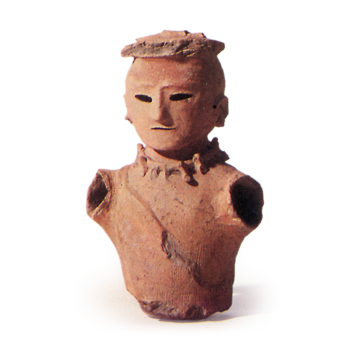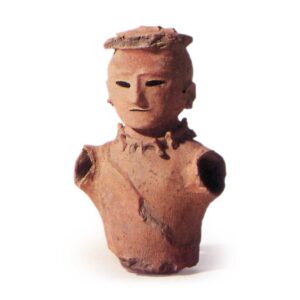
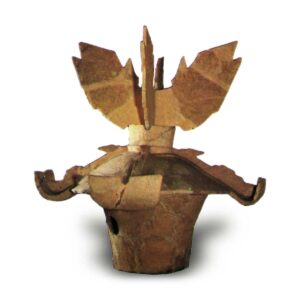
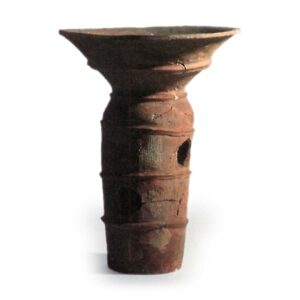
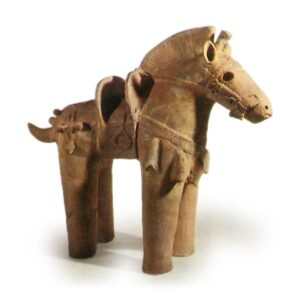
Haniwa are yellowish-brown to reddish-brown unglazed clay objects made from the lower part of the outer surface of burial mounds in Japan between the 4th and 7th centuries. They are found in a wide range of areas in Honshu, Shikoku, and Kyushu, excluding Aomori Prefecture. While earthenware is usually made of dense clay, haniwa of the 4th and 5th centuries are generally made of clay mixed with a lot of sand and gravel, and are generally not very hard. In the 6th and 7th centuries, reddish-brown clay clay ware with a hardened reddish-brown color appeared. However, there are also hard Sue quality Haniwa clay figures that are baked in dark purple or grayish-black color. Haniwa is a hollow clay product made by piling up or joining clay strings or plates. One of the characteristics of Haniwa is that it has a remarkable brush pattern, which is the mark of the tool used to prepare the surface during the molding process. There are various theories about the purpose of Haniwa in Kofun, but all of them are valid only for a limited period, and no convincing hypothesis has been proposed about Haniwa as a whole. There is a view that the site where haniwa terra-cotta tombs were found is recognized as a ritual site, but it is necessary to understand the actual condition of the site in order to determine that it is a ritual site. Haniwa is roughly classified into cylindrical Haniwa and figurative Haniwa based on its shape. There are two types of cylindrical haniwa, ordinary cylindrical haniwa and morning glory cylindrical haniwa, and jar-shaped haniwa also belongs to this category. Haniwa Haniwa is made of various shapes of things, and it is subdivided into Haniwa Haniwa, Haniwa Haniwa, animal Haniwa and human Haniwa according to the kind of things that the creator tried to imitate. Haniwa Haniwa includes houses, warehouses and barns. There are many types of Haniwa, such as crucibles, cups, haniwa, caps, hips, lids, shades, swords, spears, bows, tomo, shields, armor, weed slips, boats and other things that are not known what they represent. Animal haniwa include chickens, chicks, waterfowl, hawks, dogs, horses, cows, deer, boars, and monkeys. Haniwa figures have many variations in appearance and possessions such as male-female, standing and seated figures, and plain and armed figures. Haniwa is often described as “lid-shaped haniwa” or “horse-shaped haniwa”, or as “haniwa lid” or “haniwa horse”, adding the name of the object after the haniwa. In this way, it is called Haniwa cylindrical Haniwa house, Haniwa animal, etc. In any case, the name of the object is added after the Haniwa. In any case, the contents of Haniwa are the same. The term “haniwa clay figurine” was once used for human haniwa, but it is rarely used nowadays. The average size of cylindrical Haniwa is 3 to 400 cm in diameter and 5 to 600 cm in height, with four or five convex bands around the outer circumference. There are some relatively old ones with a diameter of up to one meter and some with an oval shape. The holes are often made in two of the several tiers separated by convex bands in mutually perpendicular directions, but there are also cases in which there are more than two tiers.
The shape of the holes is overwhelmingly circular, but there are also triangular, square, semicircular, and shaped holes. Some of them, such as the cylindrical haniwa excavated at the Nunome site in Tenri City, Nara Prefecture, have several to a dozen square, triangular, or semicircular perforations on three of the four levels. However, the Nunome site is presumed to be a ritual site. Cylindrical Haniwa is a cylindrical Haniwa with a few centimeters of height as its base, on top of which clay strings of a few centimeters width are piled up in a ring or rolled up to prepare the outer surface, and then a convex band is attached and perforated to form it. The upper part of the cylindrical Haniwa is called “Asagao Haniwa” which is made in the same way as the cylindrical Haniwa, and the upper part of the cylindrical Haniwa is made in the shape of a jar with an open mouth. The upper part of the cylindrical Haniwa is made in the same way as the shoulder of the open-mouthed jar-shaped earthenware, and it is called “Asagao Haniwa”. The shape of the haniwa is a jar with a hole in the bottom before firing. The molding method is almost the same as that of earthenware. The clay clay is used to make the clay body and the details are added to make the shape. The clay is made by piling up clay cords and adding details. Haniwa is often made by lining up clay strings, so it can be said that Haniwa is a modeling product made of clay strings. In the case of Haniwa, a cylindrical stand is made first, then the clay strings are piled up from the legs to the body and then to the head, and then short arms are attached to the simplified figure, holes are cut for the eyes and ornaments are attached, and the details are finished. The height of Haniwa is from 7 to 80cm to 160cm including the stand, but the height of ordinary Haniwa is 4 to 50cm, and the height of Haniwa which represents a bow in the left hand is less than 40cm. The ratio of the size of Haniwa is not only unrealistic, but also the composition and details of each Haniwa are not realistic. Hasumi Shigeyasu understood that Haniwa is partially formed based on cylindricality. He explained that the cylindricality means a geometrically abstracted cube, and that it is based on a primitive three-dimensionalism, noting that the figure lacks a sense of unity as a whole, yet it captures its parts with great clarity. Seiroku Noma analyzed the beauty of haniwa, and pointed out the beauty of nostalgia, beauty of materials, beauty of composition, and beauty of expression, and emphasized that the beauty of haniwa is based on simplicity, frankness, and healthiness. Regardless of the truth or falsehood of this view, Noma’s point that the unique beauty of Haniwa is not in any of these, but in the creation of a hollow image from the beginning by clay strings, is noteworthy in relation to the production of earthenware. Noma’s point that the unique sculptural beauty of haniwa is not any of these, but the fact that the clay cord is used to create a hollow image from the beginning, should be noted in relation to the production of earthenware. Haniwa clay figurines have been widely used as materials for studies of clothing, architecture, and vessels in the Kofun period. Haniwa is still an important material for these studies, but it is necessary to take into consideration that Haniwa is not necessarily a realistic representation of the clothing and housing of the time. Haniwa clay figurines were fired in cellar kilns.
While the number of Haniwa in the mounds is estimated to be enormous, only a few examples of Haniwa kiln sites were known outside of Kanto area, but in 1969, Haniwa kiln sites were excavated for the first time in the Kinai area in Osaka prefecture. Kiln No. 1, which is almost complete, is 6.75 meters long and 1.56 meters wide. The width of the kiln narrows to about 40 centimeters at the back wall, and it is assumed that a flue was attached here. The kiln No. 2 has a firing section with seven or more floor panels, and the floor slopes about 10 degrees. The part considered to be the burning section slopes gently and has a cross section close to a U shape.
The structure of this kiln is clearly the same as that of Sue ware kilns. It is still unknown in what kind of kiln the magnificent haniwa (clay figurines) erected in the tombs from the 4th century to the beginning of the 5th century were fired. In many cases, ten to a dozen haniwa kilns are found in a group. In Mawatai, Katsuta City, Ibaraki Prefecture, 13 residential workshop sites, more than 15 clay pits, and Haniwa accumulation sites were found around 14 kiln sites, and it was revealed that only two or three of the 14 kilns were used at the same time. Based on this fact, Hatsushige Otsuka speculates that haniwa in the eastern part of Japan were produced by the cooperation of small groups of two or three families, and that the size and composition of these groups differed greatly from those in the advanced Kinai region. Hatsushige Otsuka speculates that the size and composition of the groups in the Kinai region differed greatly from those in the more advanced areas of the Kinai region. According to the “Nihon-shoki” (Chronicles of Japan), the “Dojishibu” were a group of people whose occupation was the production of clay vessels. According to the Nihon-shoki (Chronicles of Japan), in the 32nd year of Emperor Taruhito’s reign, when Empress Hiyabazuhime no Mikoto died, Nomi-no-Sukune summoned Ibaijin from Izumo to make human, horse and various other objects in haniwa clay as a substitute for her death. The emperor was so pleased that he named the clay object Haniwa-zu Ehime-no-Mikoto’s tomb “Haniwa-nuri” (clay figurine). Nomi-Sukune became the vassal of Dojibu for this achievement. This is said to have been the origin of the Dojiburen and others who were in charge of the emperor’s mourning and burial.
However, this haniwa origin legend is generally discredited. The time of appearance of various types of haniwa revealed by archaeology is different, and it is because of the discrepancy with this legend. The name “Haniwa” is derived from this legend. The origin of Haniwa is found in the special tableware and jar-shaped earthenware of the late Yayoi period developed in the Kibi area (all of Okayama prefecture and the eastern part of Hiroshima prefecture), as Yoshiro Kondo and Shuji Harunari have shown. The earliest examples are the cylindrical haniwa and jar-shaped earthenware excavated from the Tsugetsuki No. 1 burial mound in Okayama City, which were recognized as the earliest examples of haniwa and jar-shaped earthenware. The earliest example of this type of haniwa was found in the Miyazu No. 1 burial mound in Okayama City, and the oldest example of this type of haniwa was found in the Miyazu No. 1 burial mound in Okayama City. Goto Morikazu’s view is that the house-shaped haniwa was made as a dwelling place for the dead, and the figures, animals, and equipment represent a funeral procession for the dead. Kobayashi Yukio shows that some of the early house-shaped haniwa and vessels may be considered as a deity’s dependents prepared for rituals, and emphasizes that as time went by, people tended to make taller objects to make them more visible.
Based on an array of haniwa (clay figurines) found in the Hachimanzuka burial mound in Gunma-cho, Gunma-gun, Mizuno Masayoshi concluded that “all the organizations that support the powerful families perform their duties in the ritual, military groups use their staffs as pincers, literati groups arrange their appearance solemnly, and professional groups perform the related entertainment based on their duties. The military group acted as a guard between the military and civilian groups. This ritual is said to be a way for a new chief to take over the spirit of the dead chief buried at the site of the tomb. The cylindrical haniwa were placed in two levels, one at the top of the mound and the other at the foot, or in three levels including the middle level. The three tiers of Haniwa are arranged in a row. The house-shaped haniwa and the container-shaped haniwa were first placed in the burial area, but later they were placed in the front part as well. The cylindrical haniwa were placed on the outer bank of the moat when the burial mound was surrounded by a moat, and also around the outside of the mound when a square platform was set up.
In the Goshikizuka tumulus in Tarumi Ward, Kobe City, which is a 197-meter-long, three-tiered, front-recessed circular tomb, it is estimated that there were 220 pieces of cylindrical haniwa on the mound, and the largest tomb in Japan, the Nintoku Imperial Tomb in Sakai City, is 486 meters long and has a diameter of 249 meters for the rear circle, with an estimated total of over 20,000 cylindrical haniwa including the outer bank alone. It is estimated that the number of cylindrical haniwa alone, including the outer bank, exceeds 20,000. In the Kanto region in the 6th century, the arrangement method of placing the houses, figures, animals and cylinders on the side of the tomb, which is easy to be seen, and only the cylindrical haniwa on the other side, became popular. In the Himezuka burial mound in Yokoshiba-cho, Yamatake-gun, Chiba Prefecture, more than 40 pieces of human and material haniwa were excavated over a length of about 50 meters from the corner of the front part to the rear part, and were restored to their original positions on the mound. (Yukio Kobayashi, “Essays on the Origin of Japanese Culture,” 1) Josuke Nogami, “Haniwa Kiln Site at Habikino City,” “Archaeological Research,” 16-3 Hatsushige Otsuka, “Formation of the Toukoku Kofun,” Shosuke Sugihara and Risan Takeuchi, “Ancient Japan,” 7) Masayoshi Mizuno, “Haniwa Entertainment Theory,” Risan Takeuchi, “Ancient Japan,” 2.

